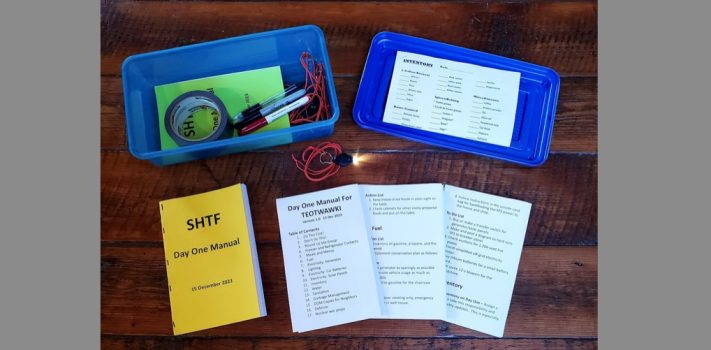by St. Funogas, Survival Blog:

(Continued from Part 3.)
8. Simple Electricity: Car Batteries and “Solar Generators”
Car-battery electric systems are basically a DIY “solar generator” and are easily put together at a fraction of the cost of commercial ones using three inexpensive components. As mentioned, solar generators don’t actually generate electricity and are really just large portable batteries with some extra features. They’re better referred to as “portable power stations.” They can be recharged three ways: solar panels ranging from 25-100 watts, 120-v house electricity, or 12-v vehicle electricity via the cigarette-lighter plug. They’re handy for many functions such as lighting, recharging laptops, and other items which use a USB cord. They can also run low-wattage appliances.
TRUTH LIVES on at https://sgtreport.tv/
In a forthcoming article I discuss how to put a solar-charged one together for as little as $75 as well as the benefits of spending more money to use a 12-v lithium battery instead of a lead-acid car or deep-cycle battery.
My DOM Action List
1. Check the charge of all 12-v batteries:
Portable power stations
Deep-cycle battery in the well house
Both vehicles
Riding mower
All core batteries
2. Inventory 12-v battery maintenance supplies: test kits, gloves, pipettes, etc.
3. Begin charging everything that is rechargeable using well-house solar chargers, SunnyBoy SPS, 100-watt solar panel, and while multi-tasking the generator.
portable power station
night-vision equipment
phones
laptops
drills
flashlights
driveway alarms
Begin charging the portable power station. If not already fully charged, top it off while the generator is topping off the water tank. When not in use, the model I have (EBL MP 500) will maintain a 100% charge for months. The manufacturer recommends topping it off every three months if not in use.
Charge phones, night-vision equipment, laptops, tools, and other rechargeables. Phones likely won’t be working after Day One but most of the other phone apps will continue to work.
Independent systems – With DIY car-battery systems it’s best to have as many independent dedicated electric systems as possible, especially critical ones like water and lighting. My backup plumbing system, solar water heater, and lighting systems are all independent. The plumbing and water-heater units each have multiple USB ports for recharging various items.
9. Lighting
Contrary to what it might seem, lighting is a difficult prep for TEOTWAWKI and is possibly something most preppers haven’t adequately prepared for to survive the first year. One easy way to remedy this is using a car-battery system as discussed in Section 8.
My DOM Action List
1. Leave a lantern-style rechargeable LED lamp in the bathroom, bedside, kitchen counter, and by reading chair.
2. Don’t use lights where dim natural light is sufficient.
3. Implement 12-volt lighting systems for the kitchen and living room. These are stored in the well house with many other 12-v items and supplies.
4. Carry key-chain flashlight around my neck at all times until the new routines are habits
5. Keep rechargeable flashlights and headlamps charged and topped off at all times.
6. Save candles as a last resort or for special uses since they have limitless storage life.
My DOM To-Do List
1. Buy more rechargeable flashlights: table-top “lantern” styles, headlamp, hand-held, and key chain.
2. Buy more DIY LED components and experiment to find best combination of low energy usage vs. sufficient luminosity.
3. Start using battery charger for AA, AAA, etc. batteries to see how long to charge, life expectancy of rechargeable batteries
4. Assemble 12-volt battery lights for kitchen food-prep area to keep on hand.
CONSIDERATIONS WHEN PLANNING OUR LIGHTING PREPS
There’s much more to prepping for lighting than buying candles and kerosene lamps.
Speaking from experience, when planning our preps we sometimes get stuck in a normalcy mindset and don’t take into consideration how certain things will differ after the SHTF. With lighting for example, we plan on replacing light bulbs with candles and kerosene lamps without adequately considering that they can’t come even close to replacing the level of lighting we currently enjoy in our pre-SHTF lifestyle. For most, bright cheery well-lit homes will be replaced by dimly-lit rooms with soot-blackened walls and ceilings and the ever-present smell of kerosene filling our nostrils.



